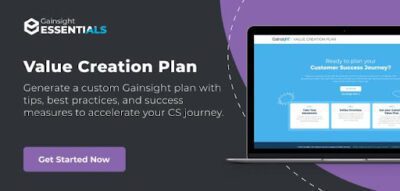The customer success (CS) community has come a long way in the last ten years since our first Pulse Conference in 2013. For many CS professionals, there is a clear track from Customer Success Manager (CSM) to Team Lead to Head of CS and eventually (Chief Customer Officer) CCO. Regardless of where you start your career in customer success, when the time comes to helm a CS program for the first time, the sheer number of things to address can be daunting. How can you make a quick impact? How do you translate CS best practices you’ve read about to generate actual outcomes for customers at your organization?
Rather than leave first-time CS leaders scratching their heads and wondering what to do, we’re sharing what’s worked for other leaders who are similarly leading teams that are early in their CS maturity. Our Grow and Tell webinar series hosted by Tim Van Lew is the latest resource for the tried-and-tested approaches CS leaders have proven in their programs.
In a recent session, Genesis Lee, VP of Global Customer Experience at Allbound, shared her tips and priority to-dos in the early weeks and months for this SaaS partner relationships management platform.
Tip #1: Establish Your CS Team Structure to Mirror the Ideal Customer Experience
Unless you’re building a team from scratch, a new Customer Success leader will inherit an existing team and departmental structure. In the case of Allbound, Genesis stepped into a team of four CSMs and a single Team Lead. As is common in many early CS programs, CSMs were wearing many hats with responsibilities that included onboarding, training, ongoing management, upsells, and renewals. This approach was stunting revenue growth because CSMs were forced to prioritize reactive troubleshooting activities.
To set up an improved structure and approach, the Allbound team first focused on the ideal customer experience they wanted to create. Viewed through the customer experience (CX) lens, a more effective structure became clear:
- Dedicated implementation resources focused on supporting a smooth Sales-to-CS handoff. Their effort was tightly focused on project management of the onboarding and training process in order to expedite time-to-value (TTV) and establish a strong foundation for long-term success.
- A technical support team was established, and in the first 12 weeks, headcount was increased by three. This was hugely successful in moving reactive tasks off the backs of CSMs and usually enabled customers to get their issues resolved in a more timely manner.
- The CSM team shifted to become customer advocates. They were now able to leverage their SaaS and partner program expertise to better counsel customers on optimizing the platform. That trust and strategic relationship also enabled CSMs to find intuitive opportunities for expansion revenue and eased renewals—both are responsibilities for CSMs at Allbound.
Although this may not be the right model for every program, having role clarity aligned to the customer experience helped keep all aspects of the CS team focused, and in the end supported an improved experience for the customer.
Tip #2: Create Company-wide Buy-in for CS by Aligning to Cross-Functional KPIs
Despite the upside potential CS offers to organizations in terms of growth, some businesses continue to view customer success as a cost center. As a result, getting buy-in and support throughout the company can be a challenge. An important goal for a new CS leader is to determine how quickly you can show results for your efforts and justify return on investment.
An important tip offered in this Grow and Tell session was for the CS leader to work with each department head to get to the metrics and KPIs that were important to the other departmental leaders. The CS team can then either align to those same metrics, or establish correlated KPIs of their own which can guide short and long-term efforts for CS.
Often, this exercise will help to identify tasks that customer success can help take off the plate of other departments. Examples include a reduction in support tickets that consume product team resources, or renewal work that stays off the to-do list of the sales organization.
Helping other departments create efficiency while supporting their KPIs will definitely shift how cross-functional teams view CS. But, it’s also important to manage expectations for when and how these objectives will be achieved. It doesn’t happen overnight, so it’s important to set clear markers on how the work will shift over time.
Tip #3: Motivate CSM Performance Through Creative Compensation
Building a team with the right structure that garners respect from others throughout the company is a big effort. Once you create momentum and get the right people in the right role, it’s as important to keep those team members. CSM burnout can be an issue for many teams, especially if they are focused on firefighting throughout much of their day.
At Allbound, getting creative with CSM compensation not only helped motivate individual CSMs, but also helped foster teamwork within the department. The main variable comp component offered is based on a group net retention number. Then the group number is achieved and individual payouts get calculated based on each CSMs’ gross retention number. The group target emphasized teamwork and resulted in team members being eager to support each other.
In addition to the group KPI, team members also sought incentives for individual achievement. Another layer of variable compensation for Allbound CSMs is based on expansion revenue quota that includes an accelerator when hit. This approach has helped the company double its expansion revenue through closed-won Customer Success Qualified Leads (CSQLs).
Allbound also offers activity-based spiffs that align with the organization’s business strategy over the course of the year. For example, in one quarter, they wanted to improve the percentage of occurred QBRs, so the spiff was focused on that initiative.
Just like team structure, compensation for CS teams becomes clearer when you consider the customer experience that you want to create. When you incentivize activities that help the team keep the customer journey oriented toward customer outcomes, it’s a win-win for everyone.
Tip #4: Build a Foundation for Efficiency at the Onset
When you’re operating in a high-growth business, it’s important to look out ahead of the resources you’ll need to support company growth targets. That will help chart a capacity plan that can scale for growth without scaling costs. In order to scale CSM capacity, it’s imperative to know what the roadblocks and time-wasters are in their day. Holding chairside sessions with CS team members is a great way to collect this insight. Going through a team member’s day along with them will help identify clear areas for resource optimization.
Following this approach at Allbound, it was evident that the team needed a more efficient method of building proposals for renewal and upsells. It was also observed that CSMs were spending way too much time researching product usage in support of a manual process to calculate customer health scores. Another inefficiency was that each CSM had to spend hours preparing for business reviews.
Each of these inefficiencies was addressed with new processes, Digital Customer Success tactics, and automation in tools, including Gainsight, which drastically opened up capacity throughout the CS team. In conjunction with understanding trends in new sales, the team was able to better establish a 3-year hiring plan that will coincide with growth targets for the company.
While each of these tips is important to prioritize in your newly emerging Customer Success program, Genesis reinforced that her number-one advice for all CS leaders is to start with the experience you want to deliver and then create the capacity in your team to deliver on that.
Learn More
What should you prioritize for your customer success journey? Take two minutes to complete the Gainsight Value Creation Plan and find out:

